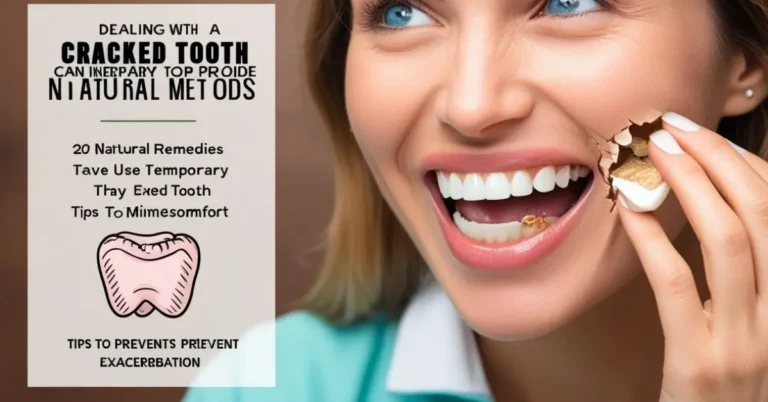Dealing with a cracked tooth can be both painful and stressful. While dental intervention is necessary to repair the damage fully, there are natural methods that can provide temporary relief, minimize discomfort, and protect the tooth from further harm. This guide will cover various natural remedies, tips to prevent exacerbation, and when to seek professional help.
Understanding a Cracked Tooth
A cracked tooth occurs when the enamel is compromised, leading to splits or fractures in the tooth structure. These can range from superficial cracks (craze lines) to more severe ones that expose the pulp. Common causes include biting hard foods, trauma, teeth grinding, or age-related wear.
While enamel cannot regenerate, natural remedies can alleviate symptoms like pain and swelling. Here’s how you can address a cracked tooth naturally.
Natural Remedies for a Cracked Tooth
1. Saltwater Rinse
A warm saltwater rinse is one of the simplest and most effective remedies. Salt is a natural disinfectant, helping to reduce bacteria in the mouth and prevent infections.
- How to use:
Mix half a teaspoon of salt into a glass of warm water. Swish the solution around your mouth for about 30 seconds and spit it out. Repeat this process 2–3 times daily to maintain oral hygiene and soothe discomfort.
2. Clove Oil
Clove oil contains eugenol, a compound with natural anesthetic and antiseptic properties. It can numb the affected area and reduce pain.
- How to use:
Apply a small amount of clove oil to a cotton swab or cotton ball. Gently dab it onto the cracked tooth or surrounding gums. Avoid swallowing the oil. Use this remedy 1–2 times daily as needed.
3. Cold Compress
A cold compress can help manage swelling and reduce pain caused by inflammation around the cracked tooth.
- How to use:
Wrap a few ice cubes in a clean cloth or towel. Hold it against the cheek near the affected tooth for 15–20 minutes. Repeat every few hours as needed.
4. Turmeric Paste
Turmeric is a natural anti-inflammatory agent that can help alleviate pain and swelling. It also has antimicrobial properties.
- How to use:
Mix a teaspoon of turmeric powder with a few drops of water to form a paste. Apply the paste directly to the cracked tooth using a clean finger or cotton swab. Leave it on for a few minutes before rinsing your mouth.
5. Hydrogen Peroxide Rinse
Hydrogen peroxide is an excellent antibacterial agent that can prevent infections.
- How to use:
Dilute 3% hydrogen peroxide with an equal amount of water. Swish the solution in your mouth for 30 seconds and spit it out. Use this remedy once a day, ensuring not to swallow the solution.
6. Garlic
Garlic has natural antimicrobial properties and can help numb pain when applied directly.
- How to use:
Crush a garlic clove to release its juices and apply it to the affected tooth. Alternatively, chew a fresh clove slowly. Use this remedy 1–2 times daily.
Tips to Prevent Further Damage
While addressing the immediate symptoms, it’s essential to avoid worsening the crack.
1. Stick to Soft Foods
Avoid hard or crunchy foods that can put pressure on the cracked tooth and cause it to worsen. Opt for a diet consisting of soft items like yogurt, mashed potatoes, soup, and smoothies until you can see a dentist.
2. Chew Carefully
Chew on the side of your mouth opposite the cracked tooth to reduce pressure and prevent further damage.
3. Maintain Oral Hygiene
Gently brushing and flossing around the cracked tooth can prevent food particles and bacteria from settling in the crack, reducing the risk of infection. Use a soft-bristled toothbrush and non-abrasive toothpaste for cleaning.
4. Avoid Extreme Temperatures
Consuming extremely hot or cold foods and drinks can worsen sensitivity and increase discomfort. Stick to lukewarm options.
Comparing Natural Remedies for Cracked Teeth
| Remedy | Benefits | Ease of Use | Frequency |
|---|---|---|---|
| Saltwater Rinse | Reduces bacteria and soothes pain | Very easy | 2–3 times daily |
| Clove Oil | Numbs pain, antiseptic | Easy | 1–2 times daily |
| Cold Compress | Reduces swelling and inflammation | Easy | As needed |
| Turmeric Paste | Anti-inflammatory, antimicrobial | Moderate | Once daily |
| Hydrogen Peroxide Rinse | Antibacterial, prevents infection | Easy | Once daily |
| Garlic | Natural pain reliever, antimicrobial | Easy | 1–2 times daily |
When to Seek Professional Help
While these natural remedies can provide temporary relief, they are not a substitute for professional dental care. A cracked tooth cannot heal on its own, and delaying treatment can lead to complications such as:
- Infections: Bacteria can penetrate the crack and infect the pulp.
- Decay: Cracks can expose the tooth to decay.
- Tooth Loss: Severe, untreated cracks may require tooth extraction.
Signs You Need a Dentist
- Persistent or severe pain
- Swelling in the gums or face
- Fever or other signs of infection
- Visible pus or discharge around the tooth
Conclusion
Natural remedies can provide temporary relief and help manage the symptoms of a cracked tooth. They are effective in reducing pain, inflammation, and the risk of infection. However, these methods are not a cure, and professional dental care is essential to address the underlying issue.
By combining these remedies with good oral hygiene and preventive care, you can protect your tooth from further damage while awaiting treatment. Remember, early intervention is key to preserving your oral health and preventing long-term complications.
For a visual guide on managing a cracked tooth naturally, you may find helpful tutorials or guides on YouTube. Search for videos that demonstrate safe and effective techniques to complement the advice shared here.

